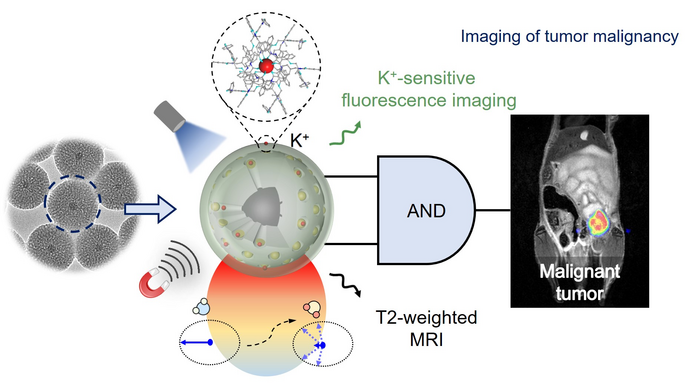Tumor malignancy identification is a vital process in the clinical management of cancer. Presently, a biopsy is the gold standard for determining if a tumor is malignant in the majority of instances. However, it is intrusive, can be extremely painful for patients, and may even raise the risk of distant metastases because of the difficult sampling procedure.
 A K+ sensitive dual-mode nanoprobe with superior magnetic resonance contrast effect and K+-specific fluorescence imaging performance is developed for non-invasive tumor imaging and malignancy identification via a cascaded ‘AND’ logic operation. Image Credit: Science China Press.
A K+ sensitive dual-mode nanoprobe with superior magnetic resonance contrast effect and K+-specific fluorescence imaging performance is developed for non-invasive tumor imaging and malignancy identification via a cascaded ‘AND’ logic operation. Image Credit: Science China Press.
Non-invasive medical imaging techniques, such as magnetic resonance imaging (MRI), computed tomography, fluorescence imaging (FI), ultrasound, etc., have been employed for non-invasive tumor diagnosis since the discovery of molecular imaging probes. However, the majority of imaging techniques frequently rely on imaging probes that are not sensitive enough to distinguish between benign and malignant tumors.
The extracellular K+ concentration is much higher in the microenvironment of malignant tumors compared to benign tissue, which is consistent with the fact that necrotic cell death and highly expressed potassium ions (K+) channels are primary characteristics of malignant tumors but not benign ones. Using this information, a recent study led by Prof. Daishun Ling of Shanghai Jiao Tong University revealed the development of a K+-sensitive dual-mode imaging probe (KDMN) to enable real-time tumor imaging while detecting malignancy.
The KDMN is made up of magnetic mesoporous silica nanoparticles with optical K+ indicators implanted in them. These nanoparticles are then covered in a K+-selective membrane that only allows K+ to flow through while blocking other cations. Improved MR contrast effect and K+-specific FI performance are provided by the KDMNs.
Additionally, for accurate tumor detection, KDMN-enhanced MRI confers reduced signals at the tumor locations. However, because of the higher extracellular K+ concentration in the malignant tumor microenvironment, KDMN-based K+-sensitive FI shows a considerable difference in fluorescence signals between malignant and benign tumors.
Notably, the self-confirmation of dual-mode imaging data has been successfully achieved by the combination of KDMN-based MRI and FI via a cascaded logic circuit, enabling accurate and reliable imaging of tumor malignancy.
National Science Review recently published the study. Dr. Qiyue Wang is the lead author, while Prof. Daishun Ling from Shanghai Jiao Tong University and Prof. Fangyuan Li from Zhejiang University are the corresponding authors.
This is the first demonstration of a K+-sensitive dual-mode imaging probe for MRI/FI-cross-checked diagnosis of tumor malignancy. And this ion-sensitive cascaded ‘AND’ logic imaging strategy would pave the way for the development of next-generation imaging probes for highly sensitive and accurate diagnosis of ion dyshomeostasis associated diseases.
Daishun Ling, Study Corresponding Author and Professor, Shanghai Jiao Tong University
Journal Reference
Wang, Q., et al. (2022) A K+-sensitive AND-gate dual-mode probe for simultaneous tumor imaging and malignancy identification. National Science Review. doi.org/10.1093/nsr/nwac080.